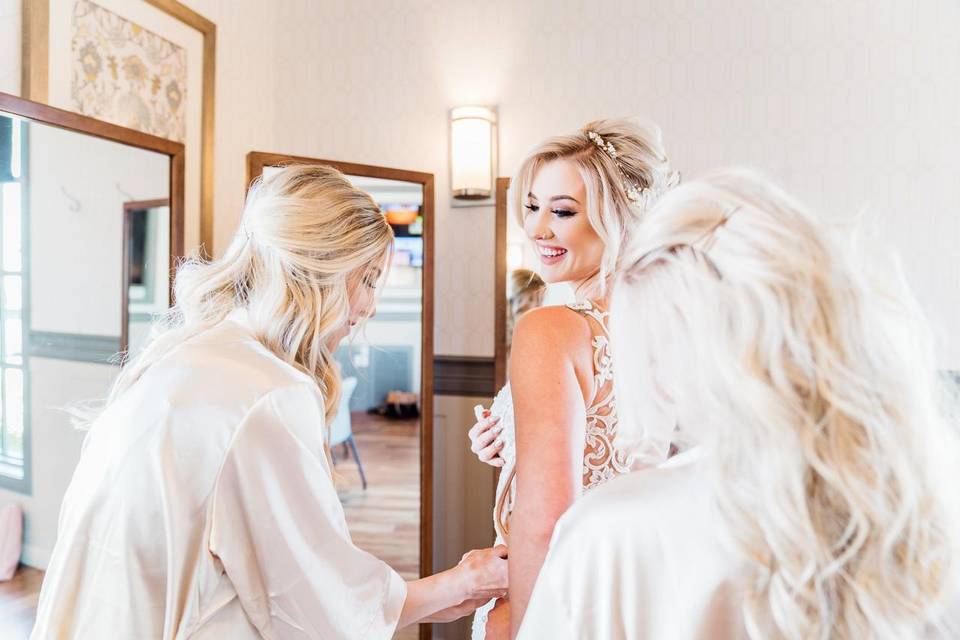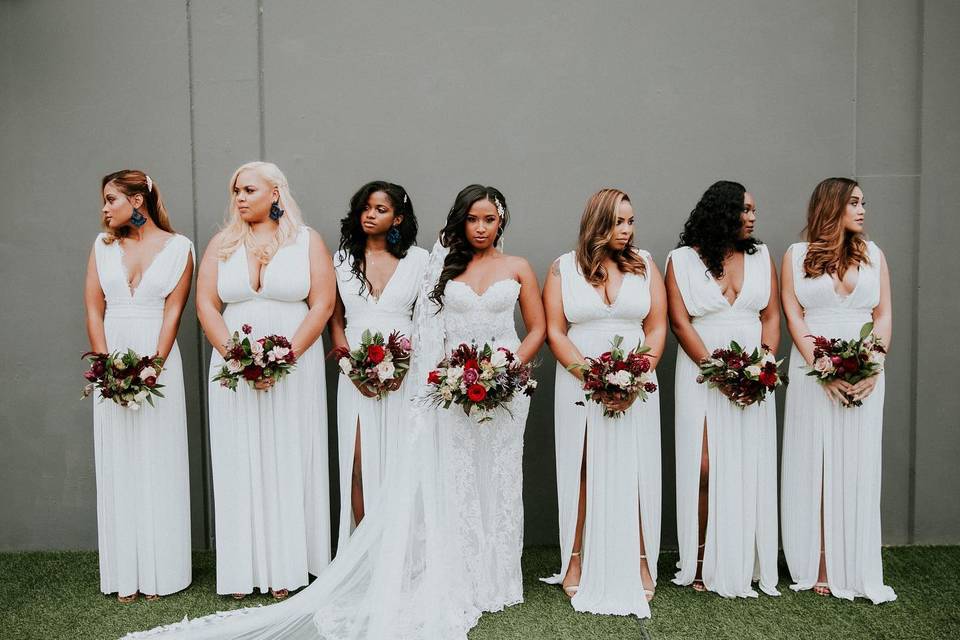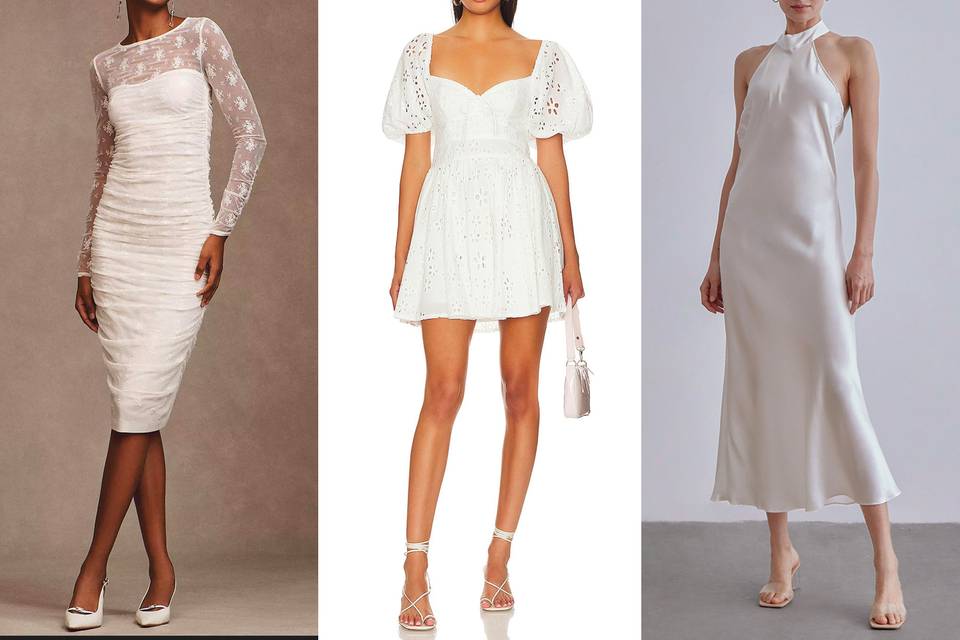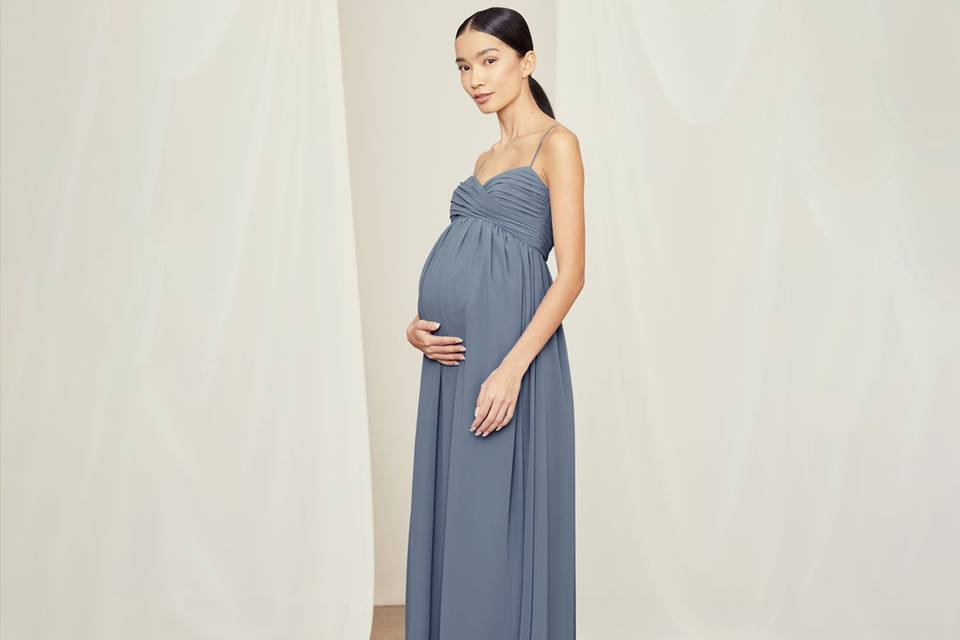Here's How Your Wedding Dress Style Affects Your First Dance
Dance instructors from across the country have chimed in with the ins-and-outs of how the style of your wedding dress affects your first dance.
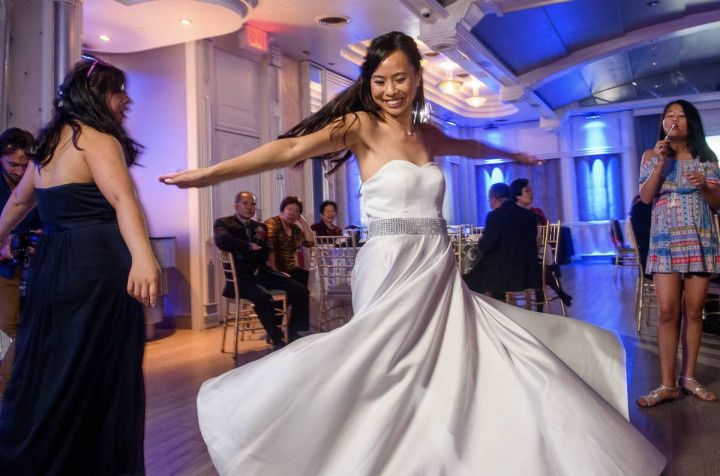
Whether you and your partner are prepping for your first dance with lessons and choreography, are going to improvise a few spins and a dip, or will be sticking with the high school sway, those few moments in the spotlight are highly anticipated—or dreaded! One thing you and your S.O. may not be considering as you’re choosing that perfect love song, though, is how your choice of wedding dress could impact your dance moves. But think about it: You’ll be wearing a fancy dress that might cling to your curves, pouf into a cloud of tulle, or fall somewhere in between—all of which will impact the way you walk, sit, and yes, dance on your wedding day.
So how does your wedding dress affect your big dance? Experts share their best advice.
If your dress is sleek and fitted…
“A skirt that hugs your body will restrict your movements, especially if it’s tight around the knees,” says Elaine Hewlett, owner of Vow to Dance in Dallas, Texas. “If it’s hard to walk in, it will be even harder to dance in!” For a bride who is dreaming of a more elaborate first dance, a trumpet or fit-and-flare silhouette will be a bit more forgiving than a mermaid, as these skirts flare out around mid-thigh instead of at the knees or lower.
“Most dances work well in a mermaid gown - you just won’t be able to take big steps,” says Elizabeth Marberry, owner of Wedding Dance Coach in Denver, Colorado. “You can still do a waltz or foxtrot, but will need to practice taking smaller steps (hip-width or narrower!), and should make sure your partner knows you won’t be traveling quite so far.” Upbeat styles, such as salsa, swing, or even a hip-hop routine are definitely still possible, as long as you’re practicing with more limited movement. As a bonus, a fitted dress is great for simple lifts because there isn’t as much material for your partner to get caught in!
If your dress is an A-line…
“I love an A-Line because you can still get nice and close to your partner while dancing, without the skirt affecting your choreography,” says Hewlett. “Just be sure you have a secure bustle that will get the train out of the way. At your fittings, make sure you can take steps in all directions without tripping - including backwards!”
Adds Marberry, “An A-Line skirt is a really carefree choice to dance in, and works with just about every dance style. Your restrictions will only come in if your dress has a fitted sleeve that will prevent you from lifting your arms.”
If your dress has a full, ball gown skirt…
“If you’re dreaming of a real Cinderella moment, look for a ball gown that’s made with layers of a softer material that gives you lots of volume but allows your partner to get close to you,” Hewlett advises. “Your partner may need to adjust to the feeling of so much fabric against their legs, but this full skirt gives you plenty of room for dancing.” In fact, Hewlett loves when brides choose big ball gowns because of the amount of drama they create when you twirl across the dance floor!
“I always remind the leading partner that there is a chance they might step on a full skirt, so they should be aware of their own steps as much as you should be aware of yours,” says Marberry. But one of her favorite things about a ball gown is that such a full skirt will hide your feet—making this the ideal time to change out of stilettos into wedges (or even sneakers!) so you can really dance your heart out. “A full skirt also means you may not be able to get so close to your partner, so a more traditional dance frame (think the upright posture of a traditional waltz) works better than a close and cozy high school sway.”
More Tips and Tricks

Talk to your dance instructor about your dress.
“As you’re choosing a song and a style of dance, take your instructor aside and describe your dress’s skirt so you can make sure the final choreography will work with what you’ll be wearing,” says Hewlett. “That way you can still keep your dress a secret from your partner, while still knowing it will be comfortable during your first dance.”
Remember your sleeves.
“If your dress has sleeves, practice lifting your arms during your fittings to test out which arm placement will and won’t work,” says Hewlett. This is great advice whether you’re choreographing a dance or are just ready to get down on the dance floor!
Wear a dress to your lessons.
“Even a simple sundress will feel different than dancing in jeans, and will be closer to how you’ll feel on your wedding day,” says Marberry. “If possible, though, wear a dress with a similar silhouette to your wedding dress.”
Practice at your final fitting.
“This may be the last time you put your dress on before your wedding day, so take a few moments to practice your steps around the fitting room,” Marberry recommends.
Slide, don’t step.
“For a dress with a tulle petticoat, slide your feet while dancing instead of taking steps,” Hewlett recommends. “A heel can easily get caught in tulle, which could tear or cause you to trip. If you can keep your heels on the ground, you’ll avoid any snags!” This is an easy one to practice during dance lessons, even if you’re not in a dress, so you can get a feel for the movement.
Put on a petticoat…
Most dance schools have petticoats that you can slip on over your jeans to mimic the shape of your wedding dress’s skirt, allowing you to get a feel for any restrictions without ruining the surprise of the dress you’ve chosen. “If you can walk in your dress, you can dance in it!” says Donatas Nacajus of Ballroom Boutique Dance Company in New York City. “Of course, the type of skirt will impact how it feels to dance, so we love to use petticoats during rehearsals to mimic the dress.” He likes that the petticoat is helpful for the bride, but also gives the leader a feeling of the skirt around their feet, as well.
…or book a private lesson.
“Another thing we highly recommend is to bring the actual wedding dress to the studio and dance at least once in it, without your partner present,” says Nacajus. “You’ll practice with just your instructor, and will be able to work out any issues that your particular dress might present.”
Grooms: Button those jackets!
“Many men think they should take off their jackets or leave them open for the dance, but it looks so much better if they have their full suit on, with the top button buttoned,” says Hewlett. If you leave your jacket open you’ll look like you have wings or are wearing a cape, and removing your jacket can be too casual for such a memorable moment.
Step away from cocktail hour to rehearse.
“Once your partner has seen your dress at the ceremony or during your first look, sneak away for a few minutes to run through your routine in your full formal attire, focusing on any lifts, turns or dips that might feel different than they did at your dance lessons,” says Marberry. Hewlett agrees, emphasizing how nice it is to get to test your dance out in your actual venue. “It will help you feel much more comfortable in the space, and is also a great private moment to share!”
Go for a second dress!
“If it is within your budget, change into a reception dress that’s shorter or has a more forgiving skirt that’s easier to dance in,” Nacajus recommends. Without any superstitions surrounding a second dress, you could even wear this one to rehearsals with your partner to really get a feel for each move!

